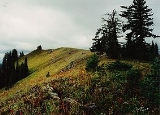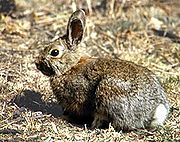
Wenaha-Tucannon Wilderness
Encyclopedia
The Wenaha–Tucannon Wilderness is a federally designated wilderness area in the Blue Mountains
of northeastern Oregon
, and southeastern Washington, United States
. It was created by the Endangered American Wilderness Act of 1978 and encompasses 177423 acres (71,800.6 ha) in the Umatilla National Forest
— 66375 acres (26,861 ha) in Oregon and 111048 acres (44,939.6 ha) in Washington.
, although some of it flows north into Washington's Tucannon River
. The Wilderness ranges in elevation from 2000 feet (610 m) on the Wild and Scenic
Wenaha River to 6401 feet (1,951 m) atop Oregon Butte.
dominates the lower drainages of the Wenaha–Tucannon Wilderness. Above about 4500 feet (1,371.6 m), it transitions to a forest of lodgepole pine
with some species of larch
, fir
, and spruce
as well. Subalpine fir
, native grasses, and forb
s are found at the highest elevations of the Wilderness.
 The Wenaha–Tucannon Wilderness is home to a variety of wildlife, including Shira's moose, Rocky Mountain elk
The Wenaha–Tucannon Wilderness is home to a variety of wildlife, including Shira's moose, Rocky Mountain elk
, bighorn sheep
, whitetail and mule deer
, black bear
, cougar, grey wolf, coyote
, snowshoe hare
, rattlesnake
, and pine marten
. Both the Tucannon and Wenaha Rivers provide spawning habitat for Chinook salmon
and steelhead trout.
Blue Mountains (Oregon)
The Blue Mountains are a mountain range in the western United States, located largely in northeastern Oregon and stretching into southeastern Washington...
of northeastern Oregon
Oregon
Oregon is a state in the Pacific Northwest region of the United States. It is located on the Pacific coast, with Washington to the north, California to the south, Nevada on the southeast and Idaho to the east. The Columbia and Snake rivers delineate much of Oregon's northern and eastern...
, and southeastern Washington, United States
United States
The United States of America is a federal constitutional republic comprising fifty states and a federal district...
. It was created by the Endangered American Wilderness Act of 1978 and encompasses 177423 acres (71,800.6 ha) in the Umatilla National Forest
Umatilla National Forest
The Umatilla National Forest, in the Blue Mountains of northeast Oregon and southeast Washington, covers an area of 1.4 million acres . In descending order of land area the forest is located in parts of Umatilla, Grant, Columbia, Morrow, Wallowa, Union, Garfield, Asotin, Wheeler, and Walla Walla...
— 66375 acres (26,861 ha) in Oregon and 111048 acres (44,939.6 ha) in Washington.
Topography
The Wehana–Tucannon Wilderness consists primarily of rugged basaltic ridges separated by deep canyons with steep slopes. Much of the area's watershed drains through into Oregon's Wenaha RiverWenaha River
The Wenaha River is a river in the Wenaha–Tucannon Wilderness in the U.S. state of Oregon.The river begins at the Wenaha Forks, where the North and South Fork Wenaha Rivers join. It then flows east for about to the small settlement of Troy where it meets the Grande Ronde River. Most of the Wenaha...
, although some of it flows north into Washington's Tucannon River
Tucannon River
The Tucannon River is a river in southeastern Washington state that flows from headwaters in the Blue Mountains to a confluence with the Snake River upstream from Lyons Ferry Park and the mouth of the Palouse River. The Tucannon itself drains and is long...
. The Wilderness ranges in elevation from 2000 feet (610 m) on the Wild and Scenic
National Wild and Scenic River
National Wild and Scenic River is a designation for certain protected areas in the United States.The National Wild and Scenic Rivers Act was an outgrowth of the recommendations of a Presidential commission, the Outdoor Recreation Resources Review Commission...
Wenaha River to 6401 feet (1,951 m) atop Oregon Butte.
Vegetation
Ponderosa pinePonderosa Pine
Pinus ponderosa, commonly known as the Ponderosa Pine, Bull Pine, Blackjack Pine, or Western Yellow Pine, is a widespread and variable pine native to western North America. It was first described by David Douglas in 1826, from eastern Washington near present-day Spokane...
dominates the lower drainages of the Wenaha–Tucannon Wilderness. Above about 4500 feet (1,371.6 m), it transitions to a forest of lodgepole pine
Lodgepole Pine
Lodgepole Pine, Pinus contorta, also known as Shore Pine, is a common tree in western North America. Like all pines, it is evergreen.-Subspecies:...
with some species of larch
Larch
Larches are conifers in the genus Larix, in the family Pinaceae. Growing from 15 to 50m tall, they are native to much of the cooler temperate northern hemisphere, on lowlands in the north and high on mountains further south...
, fir
Fir
Firs are a genus of 48–55 species of evergreen conifers in the family Pinaceae. They are found through much of North and Central America, Europe, Asia, and North Africa, occurring in mountains over most of the range...
, and spruce
Spruce
A spruce is a tree of the genus Picea , a genus of about 35 species of coniferous evergreen trees in the Family Pinaceae, found in the northern temperate and boreal regions of the earth. Spruces are large trees, from tall when mature, and can be distinguished by their whorled branches and conical...
as well. Subalpine fir
Subalpine Fir
The Subalpine Fir or Rocky Mountain Fir is a western North American fir, native to the mountains of Yukon, British Columbia and western Alberta in Canada; southeastern Alaska, Washington, Oregon, Idaho, western Montana, Wyoming, Utah, Colorado, New Mexico, Arizona, northeastern Nevada, and the...
, native grasses, and forb
Forb
A forb is a herbaceous flowering plant that is not a graminoid . The term is used in biology and in vegetation ecology, especially in relation to grasslands and understory.-Etymology:...
s are found at the highest elevations of the Wilderness.
Wildlife

Rocky Mountain Elk
The Rocky Mountain Elk is a subspecies of elk found in the Rocky Mountains and adjacent ranges of Western North America. The winter ranges are most common in open forests and floodplain marshes in the lower elevations. In the summer it migrates to the subalpine forests and alpine basins...
, bighorn sheep
Bighorn Sheep
The bighorn sheep is a species of sheep in North America named for its large horns. These horns can weigh up to , while the sheep themselves weigh up to . Recent genetic testing indicates that there are three distinct subspecies of Ovis canadensis, one of which is endangered: Ovis canadensis sierrae...
, whitetail and mule deer
Mule Deer
The mule deer is a deer indigenous to western North America. The Mule Deer gets its name from its large mule-like ears. There are believed to be several subspecies, including the black-tailed deer...
, black bear
American black bear
The American black bear is a medium-sized bear native to North America. It is the continent's smallest and most common bear species. Black bears are omnivores, with their diets varying greatly depending on season and location. They typically live in largely forested areas, but do leave forests in...
, cougar, grey wolf, coyote
Coyote
The coyote , also known as the American jackal or the prairie wolf, is a species of canine found throughout North and Central America, ranging from Panama in the south, north through Mexico, the United States and Canada...
, snowshoe hare
Snowshoe Hare
The Snowshoe Hare , also called the Varying Hare, or Snowshoe Rabbit, is a species of hare found in North America. It has the name "snowshoe" because of the large size of its hind feet and the marks its tail leaves. The animal's feet prevent it from sinking into the snow when it hops and walks...
, rattlesnake
Rattlesnake
Rattlesnakes are a group of venomous snakes of the genera Crotalus and Sistrurus of the subfamily Crotalinae . There are 32 known species of rattlesnake, with between 65-70 subspecies, all native to the Americas, ranging from southern Alberta and southern British Columbia in Canada to Central...
, and pine marten
American Marten
The American marten is a North American member of the family Mustelidae, sometimes referred to as the pine marten. The name "pine marten" is derived from the common but distinct Eurasian species of Martes...
. Both the Tucannon and Wenaha Rivers provide spawning habitat for Chinook salmon
Chinook salmon
The Chinook salmon, Oncorhynchus tshawytscha, is the largest species in the pacific salmon family. Other commonly used names for the species include King salmon, Quinnat salmon, Spring salmon and Tyee salmon...
and steelhead trout.
Recreation
Popular recreational activities in the Wenaha–Tucannon Wilderness include camping, horseback riding, wildlife watching, and hiking the area's 200 miles (321.9 km) of trails. Elk hunting and fishing are also popular pastimes in the Wilderness.See also
- List of Oregon Wildernesses
- List of U.S. Wilderness Areas
- National Wilderness Preservation SystemNational Wilderness Preservation SystemThe National Wilderness Preservation System of the United States protects federally managed land areas designated for preservation in their natural condition. It was established by the Wilderness Act upon the signature of President Lyndon B. Johnson on September 3, 1964...
- Wilderness ActWilderness ActThe Wilderness Act of 1964 was written by Howard Zahniser of The Wilderness Society. It created the legal definition of wilderness in the United States, and protected some 9 million acres of federal land. The result of a long effort to protect federal wilderness, the Wilderness Act was signed...
External links
- Wineha–Tucannon Wilderness - Umatilla National Forest

